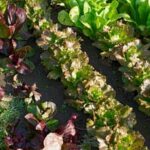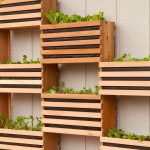Looking for creative and innovative ways to grow your own vegetables? Look no further than galvanized container vegetable gardening ideas.
This method of gardening has gained popularity in recent years for its practicality, versatility, and aesthetic appeal. In this article, we will explore the benefits of using galvanized containers for vegetable gardening, how to choose the right containers, the best vegetable varieties to grow, tips for soil preparation and planting, watering and maintenance techniques, creative design and arrangement ideas, as well as harvesting and enjoying the fruits of your labor.
Galvanized container gardening involves growing vegetables in containers made of galvanized metal. These containers are durable, long-lasting, and provide an attractive look to any garden or outdoor space. One of the main advantages of using galvanized containers is their ability to control moisture levels better than traditional terracotta or plastic pots. The zinc coating on these containers also helps prevent rust and corrosion, making them ideal for long-term use in a vegetable garden.
When it comes to choosing the right galvanized containers for your vegetable garden, there are various factors to consider such as size, drainage holes, and style. With the right containers in place, you can unleash your creativity by arranging them in unique ways that not only maximize space but also enhance the visual appeal of your garden.
Whether you have limited outdoor space or simply want a more manageable way to grow your own vegetables, galvanized container gardening offers endless possibilities for both novice and experienced gardeners alike.
Benefits of Using Galvanized Containers for Vegetable Gardening
Using galvanized containers for vegetable gardening offers a range of benefits that make it an attractive option for both seasoned gardeners and beginners. The use of galvanized containers provides several advantages, including durability, versatility, and aesthetic appeal.
Durability and Longevity
One of the key benefits of using galvanized containers for vegetable gardening is their durability. These containers are made of steel coated with zinc to withstand corrosion, making them highly resistant to rust and weathering. This means that they can last for many years, providing a long-term solution for growing vegetables in your garden.
Versatility
Another advantage of galvanized container vegetable gardening is the versatility that these containers offer. They come in various sizes and shapes, making it easy to fit them into any garden space. Whether you have a small balcony or a large backyard, you can find galvanized containers that suit your needs. Additionally, these containers can be easily moved around, allowing you to rearrange your garden layout as needed.
Aesthetic Appeal
In addition to their practical benefits, galvanized containers also add a touch of rustic charm to any garden space. Their silver-grey appearance complements the greenery of the plants and adds visual interest to the overall garden design.
Whether used individually or grouped together, these containers can enhance the aesthetic appeal of your vegetable garden while providing a functional growing space for your favorite crops. Overall, utilizing galvanized containers for vegetable gardening combines durability, versatility, and aesthetics to create an enjoyable and fruitful gardening experience.
Choosing the Right Galvanized Containers for Your Garden
When it comes to choosing the right galvanized containers for your vegetable garden, there are a few key factors to consider. First and foremost, you’ll want to select containers that are the appropriate size for the vegetables you plan to grow. Larger vegetables, such as tomatoes and peppers, will require larger containers with a sufficient depth for their roots to grow. On the other hand, smaller vegetables like lettuce and herbs can thrive in shallower containers.
Another important consideration when choosing galvanized containers for your garden is drainage. Proper drainage is crucial for the health of your plants, so be sure to select containers with drainage holes in the bottom. If your chosen container does not have pre-drilled holes, you can easily drill them yourself using a power drill with a metal bit.
It’s also worth considering the aesthetic appeal of the galvanized containers you choose for your vegetable garden. While functionality is paramount, these containers can also add visual interest to your outdoor space. Consider mixing and matching different sizes and shapes of galvanized containers for a more dynamic and visually appealing garden design.
| Key Factors | Description |
|---|---|
| Size | Choose appropriate size for the vegetables being grown |
| Drainage | Select containers with proper drainage holes or create them if necessary |
| Aesthetic | Mix and match different sizes and shapes for visual appeal |
By taking these factors into account when choosing galvanized containers for your vegetable garden, you can ensure that your plants have the best possible environment in which to grow and thrive. From ensuring proper drainage to selecting containers of the right size, these considerations are essential for successful container gardening. With the right galvanized containers in place, you’ll be well on your way to enjoying a bountiful harvest of fresh, homegrown vegetables.
Best Vegetable Varieties for Galvanized Container Gardening
When it comes to choosing the best vegetable varieties for your galvanized container garden, it’s essential to consider plants that thrive in containers and will provide a bountiful harvest. Here are some top vegetable varieties that are well-suited for galvanized container gardening:
Tomatoes
Tomatoes are one of the most popular vegetables for container gardening, and they do exceptionally well in galvanized containers. Look for compact or determinate varieties such as patio, cherry, or roma tomatoes that are specifically bred for smaller spaces. These varieties produce an abundance of delicious fruit and are perfect for growing in limited space.
Peppers
Peppers, both sweet and hot varieties, also thrive in galvanized containers. Choose compact pepper plants such as bell peppers, jalapenos, or banana peppers that are well-suited for container gardening. With the right care and maintenance, you can expect a plentiful harvest of vibrant and flavorful peppers from your galvanized containers.
Lettuce and Salad Greens
For those looking to grow leafy greens in their galvanized containers, lettuce and other salad greens are excellent choices. Varieties like looseleaf lettuce, arugula, spinach, and kale can be grown successfully in containers. These fast-growing vegetables are not only easy to cultivate but also provide a continuous harvest throughout the growing season.
By selecting these top vegetable varieties for your galvanized container garden, you can enjoy a thriving and productive garden filled with delicious homegrown produce. Whether you’re growing tomatoes, peppers, or leafy greens, these vegetables are sure to flourish in your galvanized containers with proper care and attention.
Tips for Soil Preparation and Planting in Galvanized Containers
When it comes to galvanized container vegetable gardening ideas, one of the crucial factors for success is proper soil preparation and planting. The type of soil and how you plant your vegetables can greatly impact their growth and yield. Here are some tips to ensure that your plants thrive in galvanized containers:
1. Soil Preparation: Before planting your vegetables, it’s essential to have the right type of soil in your galvanized containers. Use a high-quality potting mix that is well-draining and rich in nutrients. Avoid using garden soil as it may contain pests, diseases, or weed seeds that can harm your plants.
2. Proper Planting: When planting in galvanized containers, make sure to follow the recommended spacing for each vegetable variety to allow enough room for their roots to grow. For example, larger plants like tomatoes or peppers should be planted in the center of the container, while smaller herbs or lettuces can be planted around them.
3. Fertilization: Since the nutrients in the potting mix will eventually deplete over time, it’s important to fertilize your vegetables regularly. Choose a balanced fertilizer or organic compost and follow the instructions for application according to the specific needs of each vegetable variety.
By following these tips for soil preparation and planting in galvanized containers, you can create a healthy environment for your vegetables to grow and thrive.
| Tips | Details |
|---|---|
| Soil Preparation | Use high-quality potting mix |
| Proper Planting | Follow recommended spacing for each vegetable variety |
| Fertilization | Regularly fertilize with balanced fertilizer or organic compost |
Watering and Maintenance of Vegetables in Galvanized Containers
When it comes to watering and maintaining vegetables in galvanized containers, there are a few key things to keep in mind to ensure a successful harvest. Here are some tips to help you keep your container garden thriving:
1. Proper watering: One of the most important aspects of maintaining vegetables in galvanized containers is ensuring they receive the right amount of water. Since metal containers can heat up more quickly than traditional garden beds, it’s important to monitor the soil moisture levels regularly.
A good rule of thumb is to water when the top inch of soil feels dry to the touch. Be mindful not to overwater, as this can lead to root rot and other issues.
2. Fertilization: Because nutrients can leach out of container soil more quickly, it’s important to fertilize your vegetables regularly. Consider using a slow-release organic fertilizer or supplementing with liquid fertilizer every few weeks during the growing season. This will provide your plants with the essential nutrients they need for healthy growth and bountiful harvests.
3. Monitoring for pests and diseases: Regularly check your vegetable plants for signs of pests or disease. Since containers are isolated from the ground, they may be less susceptible to certain pests, but it’s still important to keep an eye out for any issues that could arise. Consider using natural pest control methods such as neem oil or companion planting techniques to deter unwanted visitors.
By following these watering and maintenance tips, you can set yourself up for a thriving galvanized container vegetable garden that yields a bounty of fresh produce throughout the growing season. Happy gardening.
Creative Design and Arrangement of Galvanized Containers in the Garden
When it comes to galvanized container vegetable gardening ideas, the creative design and arrangement of your containers in the garden can make a significant impact on the overall aesthetic and functionality of your space. Here are some tips and ideas for designing and arranging your galvanized containers in a visually appealing and efficient manner:
1. Vertical Space Utilization: Utilize vertical space by using hanging galvanized containers for trailing or vining vegetables such as cherry tomatoes, cucumbers, or peas. This not only adds visual interest to your garden but also maximizes the use of limited space.
2. Grouping and Clustering: Arrange your galvanized containers in groups or clusters to create a visually appealing display. You can mix different sizes and shapes of containers and arrange them in varying heights to add dimension to your garden.
3. Companion Planting: Consider companion planting when arranging your galvanized containers. Pair plants that complement each other or have beneficial growing relationships, such as planting basil with tomatoes or marigolds with vegetables to deter pests.
4. Creating Pathways: Use galvanized containers to create defined pathways within your garden. You can line the edges of pathways with containers filled with colorful herbs or flowers, creating a beautiful and fragrant walkway.
5. Seasonal Rotation: Plan for seasonal rotation by designing your garden with flexibility in mind. Consider using rolling galvanized container carts for easy repositioning and rotation of plants based on their growing seasons.
By incorporating these creative design and arrangement ideas into your galvanized container vegetable garden, you can not only enhance the beauty of your outdoor space but also maximize productivity and efficiency in your gardening efforts. With thoughtful planning and design, you can create a stunning and bountiful garden using galvanized containers.
Harvesting and Enjoying the Fruits of Your Galvanized Container Vegetable Garden
In conclusion, galvanized container vegetable gardening offers a multitude of benefits and opportunities for gardeners to grow their own vegetables in a creative and space-efficient way. The use of galvanized containers provides advantages such as durability, portability, and versatility, making them ideal for both experienced gardeners and beginners alike. By carefully selecting the right varieties of vegetables, properly preparing the soil, and maintaining a regular watering schedule, gardeners can enjoy a bountiful harvest from their galvanized container gardens.
One of the most satisfying aspects of galvanized container vegetable gardening is the ability to reap the rewards of your hard work by harvesting fresh, homegrown produce. Whether it’s plucking ripe tomatoes from a hanging planter or gathering a handful of crisp lettuce leaves from a trough-style container, there is something undeniably fulfilling about enjoying the fruits of your labor.
Additionally, the creative design and arrangement of galvanized containers within your garden can add visual interest and enhance the overall appeal of your outdoor space.
As you continue to explore different galvanized container vegetable gardening ideas and techniques, don’t be afraid to experiment with new varieties of vegetables or innovative ways to arrange your containers. With dedication and proper care, you can experience the satisfaction of growing your own food while adding an aesthetic touch to your garden with galvanized containers.
So go ahead, roll up your sleeves, get your hands dirty, and start reaping the delicious rewards that come from harvesting homegrown vegetables in your galvanized container garden.

If you’re looking to get into vegetable gardening, or are just looking for some tips on how to make your current garden better, then you’ve come to the right place! My name is Ethel and I have been gardening for years. In this blog, I’m going to share with you some of my best tips on how to create a successful vegetable garden.





